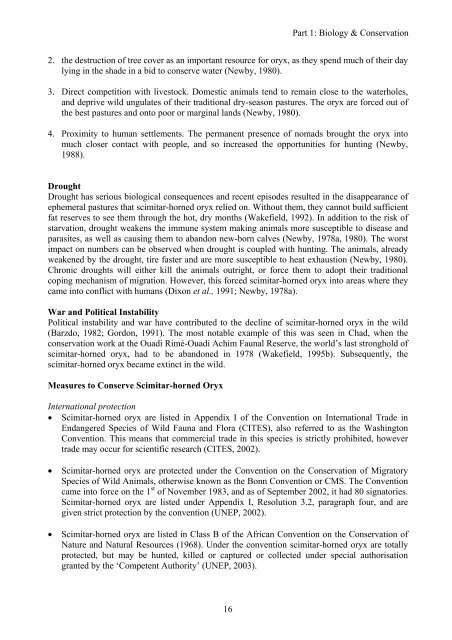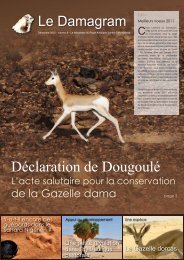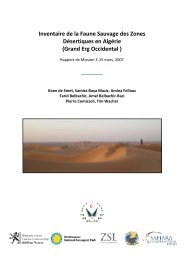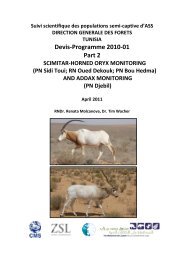The Biology, Husbandry and Conservation Scimitar-horned Oryx ...
The Biology, Husbandry and Conservation Scimitar-horned Oryx ...
The Biology, Husbandry and Conservation Scimitar-horned Oryx ...
Create successful ePaper yourself
Turn your PDF publications into a flip-book with our unique Google optimized e-Paper software.
16<br />
Part 1: <strong>Biology</strong> & <strong>Conservation</strong><br />
2. the destruction of tree cover as an important resource for oryx, as they spend much of their day<br />
lying in the shade in a bid to conserve water (Newby, 1980).<br />
3. Direct competition with livestock. Domestic animals tend to remain close to the waterholes,<br />
<strong>and</strong> deprive wild ungulates of their traditional dry-season pastures. <strong>The</strong> oryx are forced out of<br />
the best pastures <strong>and</strong> onto poor or marginal l<strong>and</strong>s (Newby, 1980).<br />
4. Proximity to human settlements. <strong>The</strong> permanent presence of nomads brought the oryx into<br />
much closer contact with people, <strong>and</strong> so increased the opportunities for hunting (Newby,<br />
1988).<br />
Drought<br />
Drought has serious biological consequences <strong>and</strong> recent episodes resulted in the disappearance of<br />
ephemeral pastures that scimitar-<strong>horned</strong> oryx relied on. Without them, they cannot build sufficient<br />
fat reserves to see them through the hot, dry months (Wakefield, 1992). In addition to the risk of<br />
starvation, drought weakens the immune system making animals more susceptible to disease <strong>and</strong><br />
parasites, as well as causing them to ab<strong>and</strong>on new-born calves (Newby, 1978a, 1980). <strong>The</strong> worst<br />
impact on numbers can be observed when drought is coupled with hunting. <strong>The</strong> animals, already<br />
weakened by the drought, tire faster <strong>and</strong> are more susceptible to heat exhaustion (Newby, 1980).<br />
Chronic droughts will either kill the animals outright, or force them to adopt their traditional<br />
coping mechanism of migration. However, this forced scimitar-<strong>horned</strong> oryx into areas where they<br />
came into conflict with humans (Dixon et al., 1991; Newby, 1978a).<br />
War <strong>and</strong> Political Instability<br />
Political instability <strong>and</strong> war have contributed to the decline of scimitar-<strong>horned</strong> oryx in the wild<br />
(Barzdo, 1982; Gordon, 1991). <strong>The</strong> most notable example of this was seen in Chad, when the<br />
conservation work at the Ouadi Rimé-Ouadi Achim Faunal Reserve, the world’s last stronghold of<br />
scimitar-<strong>horned</strong> oryx, had to be ab<strong>and</strong>oned in 1978 (Wakefield, 1995b). Subsequently, the<br />
scimitar-<strong>horned</strong> oryx became extinct in the wild.<br />
Measures to Conserve <strong>Scimitar</strong>-<strong>horned</strong> <strong>Oryx</strong><br />
International protection<br />
• <strong>Scimitar</strong>-<strong>horned</strong> oryx are listed in Appendix I of the Convention on International Trade in<br />
Endangered Species of Wild Fauna <strong>and</strong> Flora (CITES), also referred to as the Washington<br />
Convention. This means that commercial trade in this species is strictly prohibited, however<br />
trade may occur for scientific research (CITES, 2002).<br />
• <strong>Scimitar</strong>-<strong>horned</strong> oryx are protected under the Convention on the <strong>Conservation</strong> of Migratory<br />
Species of Wild Animals, otherwise known as the Bonn Convention or CMS. <strong>The</strong> Convention<br />
came into force on the 1 st of November 1983, <strong>and</strong> as of September 2002, it had 80 signatories.<br />
<strong>Scimitar</strong>-<strong>horned</strong> oryx are listed under Appendix I, Resolution 3.2, paragraph four, <strong>and</strong> are<br />
given strict protection by the convention (UNEP, 2002).<br />
• <strong>Scimitar</strong>-<strong>horned</strong> oryx are listed in Class B of the African Convention on the <strong>Conservation</strong> of<br />
Nature <strong>and</strong> Natural Resources (1968). Under the convention scimitar-<strong>horned</strong> oryx are totally<br />
protected, but may be hunted, killed or captured or collected under special authorisation<br />
granted by the ‘Competent Authority’ (UNEP, 2003).





